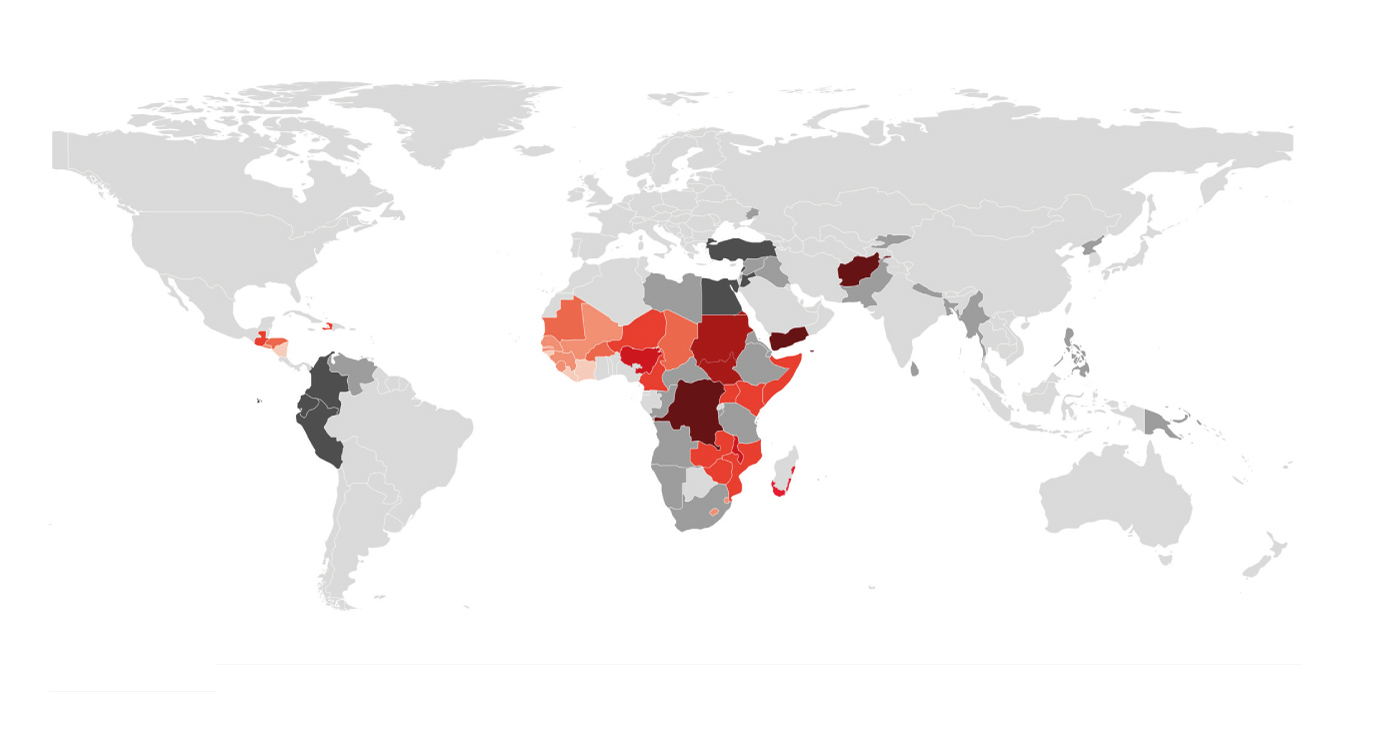
The Global Report on Food Crises is accepted as the reference document on the latest estimates of acute hunger in the world. It is a public good prepared collectively by 15 leading global and regional institutions under the umbrella of the Food Security Information Network.
More than 113 million people across 53 countries experienced acute hunger requiring urgent food, nutrition and livelihoods assistance (IPC/CH Phase 3 or above) in 2018. This report illustrates in stark terms the hunger caused by conflict and insecurity, climate shocks and economic turbulence.

Countries in Africa remained disproportionally
affected by acute food insecurity.
An additional 143 million people in a subset of 42 countries were found to be living in Stressed conditions on the cusp of acute hunger (IPC/CH Phase 2). They risked slipping into Crisis or worse (IPC/CH Phase 3 or above) if faced with a shock or stressor.
High levels of acute and chronic malnutrition in children living in emergency conditions remained of grave concern. The immediate drivers of undernutrition include poor dietary intake and disease. Mothers and caregivers often face challenges in providing children with the key micronutrients they need at critical growth periods in food crises. This is reflected in the dismally low number of children consuming a minimum acceptable diet in most of the countries profiled in this report.
INTEGRATED FOOD SECUrity phase classification (ipc) & cadre harmonisè (ch)
Households are able to meet essential food and non-food needs without engaging in atypical, unsustainable strategies to access food and income
Households have minimally adequate food consumption but are unable to afford some essential non-food expenditures without engaging in detrimental coping strategies
Households have food consumption gaps with high or above usual acute malnutrition OR accelerated depletion of livelihood assets that will lead to food consumption gaps
Households have large food consumption gaps resulting in very high acute malnutrition and excess mortality OR face extreme loss of livelihood assets that will lead to food consumption gaps
Households have an extreme lack of food and other basic needs. Starvation, death and destitution are evident
Action for disaster risk reduction and livelihoods protection
Urgent action required

Conflict and insecurity, climate shocks and economic turbulence
– the main drivers of food insecurity –
continued to erode livelihoods and destroy lives.
CONFLICT AND INSECURITY
Conflict and insecurity remained the key driver in 2018.
Some 74 million people – more than two-thirds – of those facing acute hunger were located in 21 countries affected by conflict or insecurity. Some 33 million of these people were in 10 countries in Africa; over 27 million in seven countries in Western Asia/Middle East; 13 million in three countries in South/South-east Asia and 1.1 million in Eastern Europe.
CLIMATE SHOCKS
Climate and natural disasters pushed another 29 million people into situations of acute food insecurity in 2018. As in previous years, most of these individuals were in Africa, where nearly 23 million people in 20 countries were acutely food insecure due to climate shocks
ECONOMIC SHOCKS
Economic shocks were the primary driver of acute food insecurity for 10.2 million people, mainly in Burundi, Sudan and Zimbabwe.

The world’s eight worst
food crises in 2018

















CONFLICT AND INSECURITY
Conflict and insecurity are likely to remain the primary drivers of food security crises. Protracted conflict in some countries and local insecurity and intercommunal violence in others will continue to disrupt agricultural production and markets and deprive households of their livelihood assets, accentuating their use of negative coping strategies and deepening their vulnerability to shocks. Conflict and insecurity will contribute to increasing displacement, internally or towards neighbouring countries, or will ensure people remain displaced for prolonged periods, aggravating, in most cases, the food insecurity of those fleeing and/or of host communities.
CLIMATE SHOCKS
Weather shocks and extreme climate events are expected to have a severe impact on agricultural and livestock production in several regions, including those already confronting food crises. In the Southern Africa region, dry weather has already reduced prospects for the 2019 agricultural output, while the massive destruction of livestock, livelihoods and planted crops following tropical Cyclone Idai in March 2019 will further exacerbate food insecurity in Mozambique, Malawi and Zimbabwe. In Latin America and the Caribbean, dry weather associated with El Niño conditions are expected to affect agricultural production and food prices in Colombia, El Salvador, Guatemala, Haiti, Honduras, Nicaragua, and Venezuela (Bolivarian Republic of).
ECONOMIC SHOCKS
In 2019 economic instability – often as a result of conflict, local insecurity, or political volatility – will continue to undermine the food security status of vulnerable households in the Democratic Republic of the Congo, Libya, South Sudan, the Sudan, the Syrian Arab Republic, Venezuela (Bolivarian Republic of), Yemen and Zimbabwe. The food security status of the poorest households are likely to be the most affected by rising prices of food, fuel, medicines and other essential items, and lack of work opportunities that also weaken the ability of farmers and smallholders to invest in inputs needed to increase crop yields or to build their resilience to shocks.
DISEASE OUTBREAKS
In Yemen, the Central African Republic, the Democratic Republic of the Congo, Lake Chad Basin and Cameroon’s Anglophone regions protracted or increased conflict is expected to further hinder access to health and nutrition services. Cholera and measles outbreaks are expected to persist in 2019 in many conflict and displacement affected countries and to potentially rise in settings with poor sanitation infrastructure, contamination of drinking water and lack of health services.
Number of people in IPC/CH Phase 3 or above (ranges) in 2019
